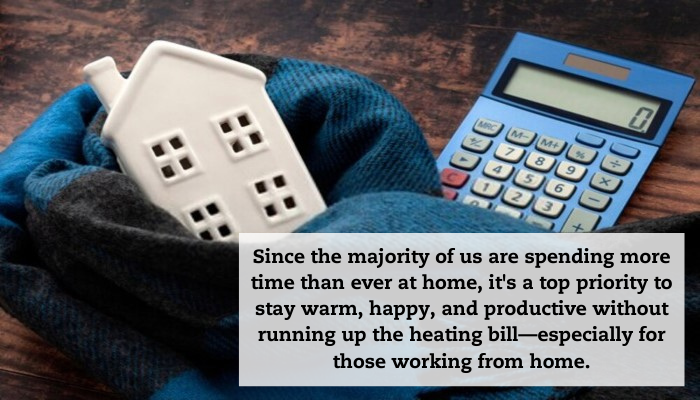All across the northern half of the United States, people are switching from AC to heating as winter approaches.
Since the majority of us are spending more time than ever at home, it’s a top priority to stay warm, happy, and productive without running up the heating bill—especially for those working from home. After all, degree for degree, heating your apartment puts more of a dent in your wallet than cooling it.
You often have more control over your utility bills than you might think. Here are 10 tips for staying cozy and comfortable in your apartment all while getting heating costs under control.
1. Heat the rooms you use, when you use them
Turn your thermostat down 7-10 °F whenever you’re outside of the apartment. Doing this for eight hours a day can reduce costs by as much as 10 percent, according to the U.S. Department of Energy. However, you don’t want to get in the habit of manually changing your thermostat over and over again. This can actually cost you more as the furnace tries to keep up by cycling off and on, again and again.
If you are working from home, you don’t have the luxury of turning the thermostat down on work days. Be careful to close the doors to any rooms when they’re not in use. Also, close the vents in those rooms so you aren’t heating unused space. Keep closet doors closed as well to direct the heat where it’s needed most.
2. Focus on warming people, not rooms
You and your family can stay extra warm this winter by adding some cozy touches to your home. Consider how blankets and textiles can help with this. For example, you may want to lay down thick area rugs around the apartment to keep your feet warm. Throw blankets in the living room, on the other hand, can make late-night Netflix binges a lot more snuggly and comfortable. You could also consider upgrading your seasonal bedding by switching to warm winter blankets and flannel sheets during the winter. All of this will help you feel comfortable even when the thermostat is set lower for the night.
3. Feel warmer with humidified air
Temperature and humidity go hand-in-hand. Remember those summer days when the high humidity made you uncomfortable? It is the opposite problem in the winter. Low humidity adds a chill to the air, making it necessary to overheat your home to compensate. Address the issue with a portable humidifier. With this appliance, you can maintain comfortable humidity levels of about 40-60 percent. Humidifying the air may also help you avoid some health issues associated with dry winter air. Chapped lips, cracked skin, and sore throats are some examples.
4. Reverse those ceiling fans
In the summer, ceiling fans draw warm air upward to help cool your home. However, as the seasons change, you’ll want to reverse the blade direction on your ceiling fan or fans. As winter approaches, choose the clockwise setting on your fan switch. Ceiling fans will force warm air downward to help maximize indoor comfort.
5. Use insulated window coverings
In the winter, thermal curtains and heavier drapes keep the heat in and the drafts out. The secret to thermal curtains is the use of multiple layers of fabric. A decorative outer layer complements your room decor. A middle, insulating layer consists of a heavier polyester, foam, or cotton flannel. A vapor barrier facing the window prevents unwanted moisture absorption.
Thermal curtains and heavier drapes often double as room darkeners. An investment in such window coverings also pays off throughout the year. In the summer, they help to keep the sun’s rays out and the conditioned air in.
6. Embrace passive solar
The sun’s light becomes heat when it is absorbed rather than reflected. Use this principle to your advantage by opening certain window coverings when it’s sunny outside. Since the sun doesn’t get as high in the sky in the winter, you’ll get the most warmth through south-facing windows.
7. Limit exhaust fan use
Exhaust fans in the kitchen and bathroom serve an important purpose: they remove odors. In the winter, however, they also pull warm air out of your home. So be sure to limit your use of your exhaust fans except when it’s absolutely necessary.
8. Focus heat on your WFH space
Family Handyman suggests that apartment dwellers consider an electric space heater. This may be an effective option if you work from home (WFH), particularly if you work in a walled-in area. However, this is a cost-effective solution only if you cut back your thermostat by at least five degrees, otherwise you will still run up your bill. Be sure to only purchase space heaters that have been tested by a safety laboratory like Underwriters Laboratory and, to be extra safe, only use the space heater while you’re awake and in the room.
9. Reduce air leakage
Draft stoppers for a popular option for preventing under-door drafts, especially for exterior-facing doors. There’s a bonus when you select a fabric draft stopper. You’ll often reduce noise transmission as well. Make your own out of fuzzy socks filled with dry rice. To keep the rice where it belongs, tie off the open end or sew it shut. You can use them on windowsills as well. Plastic or Velcro door sweeps may mar the door’s surface, so always discuss them with your property manager first before installing them.
10. Check that Sliding Door
Do you have a sliding door that gives you access to a deck or patio? If so, make sure you eliminate gaps with draft stoppers or weatherstripping. Apply removable weatherstripping to both the inside and outside of the door jamb. When you use the sliding door, always make sure it is fully closed. You’ll find more information on detecting and resolving air leaks from the U.S. Department of Energy.
About Draper and Kramer
Draper and Kramer is a family-owned company managing multifamily properties across the United States. Visit Draper and Kramer today for more articles on how to reduce your utility bills, maximize your living space, and other apartment living tips.

Since the majority of us are spending more time than ever at home, it’s a top priority to stay warm, happy, and productive without running up the heating bill—especially for those working from home. After all, degree for degree, heating your apartment puts more of a dent in your wallet than cooling it.